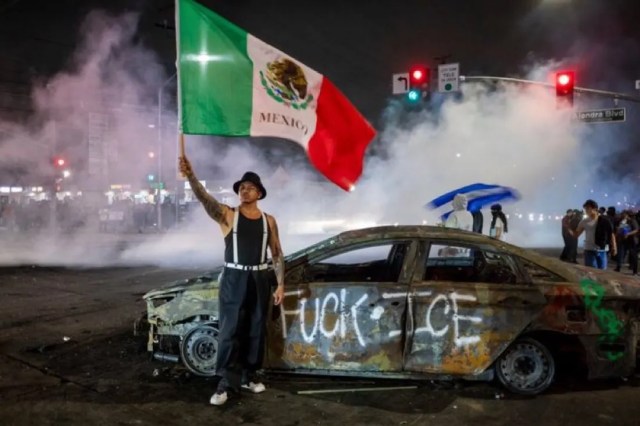It is a light flickering above the city - not a sunrise, but the twitching of police sirens, burning dumpsters, and the harsh, unforgiving presence of a state turning against its citizens. On the night of June 7 to 8, Los Angeles became the epicenter of a political tremor that can no longer be expressed in slogans or banners - but in rebellion, tear gas, and the presence of armed soldiers. Around 8 p.m. on June 7, the first units of the National Guard arrived in the metropolis. At the same time, the fury on the streets reached a new level: demonstrations against the recent deportations by ICE, against the secret transfers of detainees, against the silence of the courts turned into a chaotic mix of chants, barricades, and police batons. The trigger was the revelation of several mass arrests across California - and the growing sense that the state has lost its sovereignty to Washington.


The protests continue on June 8. In Boyle Heights, Downtown, as well as in Santa Monica and Compton, people are gathering. The tone is tense, the police visibly nervous. It is not just a protest against Trump - it is a protest against a state that has stripped itself bare. The National Guard now patrols buildings belonging to the Federal Property Management, ICE headquarters, and detention facilities. A peaceful solution seems far away. Meanwhile, the White House has not only escalated rhetorically, but also legally: President Donald Trump signed a memorandum legitimizing the deployment of the National Guard under federal command - under the pretext of protecting ICE facilities. The memorandum states:
"Numerous acts of violence and unrest have recently occurred and threaten to continue in response to the enforcement of federal law by U.S. Immigration and Customs Enforcement (ICE) and other federal officers charged with carrying out federal duties. These officers support the lawful implementation of the immigration laws of the United States. (...) To the extent that protests or acts of violence directly interfere with the execution of the law, they represent a form of rebellion against the authority of the Government of the United States."

The memorandum, signed by Trump on June 7, refers to 10 U.S.C. 12406 - a provision that allows the President to federalize National Guard troops under certain circumstances. A total of 2,000 soldiers are to be deployed for an initial period of 60 days, supported by regular armed forces. The Secretary of Defense receives broad authority - including over the withdrawal of the troops.


What is emerging is a deliberate escalation. Civil rights organizations warn of the unchecked expansion of military power on the domestic front. Governor Gavin Newsom sharply criticized the measure, calling it "constitutionally questionable" and an "attack on the federal structure of the United States."
But Los Angeles no longer needs legal commentary. It needs air to breathe. Because the night of June 9 could become the most dangerous since the protests began. It is not just tear gas and rubber bullets that haunt the city. It is the fear that what was once democracy is now being defended with weapons - against those demanding it.

War die Nationalgarde denn in LA im Einsatz? Im Netz habe ich heute schon gelesen, dass es nur ein Gerücht sei, aber ich meine, ich habe gestern im Live Stream der BBC Schilde mit deren Aufdruck gesehen. Danke für eure Berichterstattung!!!
ja, die Nationalegarde ist im Einsatz